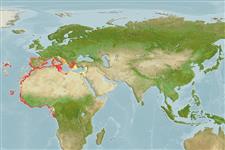Teleostei (teleosts) >
Callionymiformes (Dragonets) >
Callionymidae (Dragonets)
Etymology: Synchiropus: Greek, syn, symphysis = grown together + Greek, cheir = hand + Greek, pous = foot (Ref. 45335).
Eponymy: In Greek mythology, Phaëton was the son of the sun god Helios. The name means ‘shining one’. The reason for applying this name to the dragonet was not explained. (Ref. 128868), visit book page.
More on author: Günther.
Environment: milieu / climate zone / depth range / distribution range
Ecology
Marine; demersal; depth range 80 - 848 m (Ref. 56504). Subtropical; 45°N - 4°S, 32°W - 36°E
Eastern Atlantic: Portugal and the Azores to Gabon, including the Mediterranean.
Size / Weight / Age
Maturity: Lm ? range ? - ? cm
Max length : 18.0 cm TL male/unsexed; (Ref. 5968); 12.0 cm TL (female); common length : 12.0 cm TL male/unsexed; (Ref. 5968); common length :8 cm TL (female)
Depth range from 80-650 m (Ref. 06941) and from 302-848 m in the eastern Ionian Sea (Ref. 56504). Found on sand or mud bottoms. Territorial, males aggressive to each other. Feeds on small bottom invertebrates, mainly worms, snails and crustaceans. Eggs and larvae pelagic (Ref. 5968). Minimum depth reported from Ref. 26999.
Life cycle and mating behavior
Maturity | Reproduction | Spawning | Eggs | Fecundity | Larvae
Davis, W.P and R. Fricke, 1990. Callionymidae. p. 921-924. In J.C. Quero, J.C. Hureau, C. Karrer, A. Post and L. Saldanha (eds.) Check-list of the fishes of the eastern tropical Atlantic (CLOFETA). JNICT, Lisbon, SEI, Paris; and UNESCO, Paris. Vol. 2. (Ref. 6941)
IUCN Red List Status (Ref. 130435: Version 2024-2)
Threat to humans
Harmless
Human uses
Fisheries: of no interest
Tools
Special reports
Download XML
Internet sources
Estimates based on models
Preferred temperature (Ref.
123201): 10.8 - 14.9, mean 13.8 °C (based on 127 cells).
Phylogenetic diversity index (Ref.
82804): PD
50 = 0.5000 [Uniqueness, from 0.5 = low to 2.0 = high].
Bayesian length-weight: a=0.00794 (0.00466 - 0.01353), b=2.78 (2.64 - 2.92), in cm total length, based on LWR estimates for this species & (Sub)family-body (Ref.
93245).
Trophic level (Ref.
69278): 3.4 ±0.45 se; based on food items.
Generation time: 7.0 ( na - na) years. Estimated as median ln(3)/K based on 2
growth studies.
Resilience (Ref.
120179): Medium, minimum population doubling time 1.4 - 4.4 years (Preliminary K or Fecundity.).
Fishing Vulnerability (Ref.
59153): Low to moderate vulnerability (35 of 100).
Nutrients (Ref.
124155): Calcium = 81.6 [15.3, 237.6] mg/100g; Iron = 1.28 [0.46, 4.77] mg/100g; Protein = 3.63 [0.00, 7.34] %; Omega3 = 0.602 [0.257, 1.381] g/100g; Selenium = 24.5 [5.4, 70.2] μg/100g; VitaminA = 18.4 [6.5, 52.4] μg/100g; Zinc = 0.871 [0.436, 1.712] mg/100g (wet weight);
